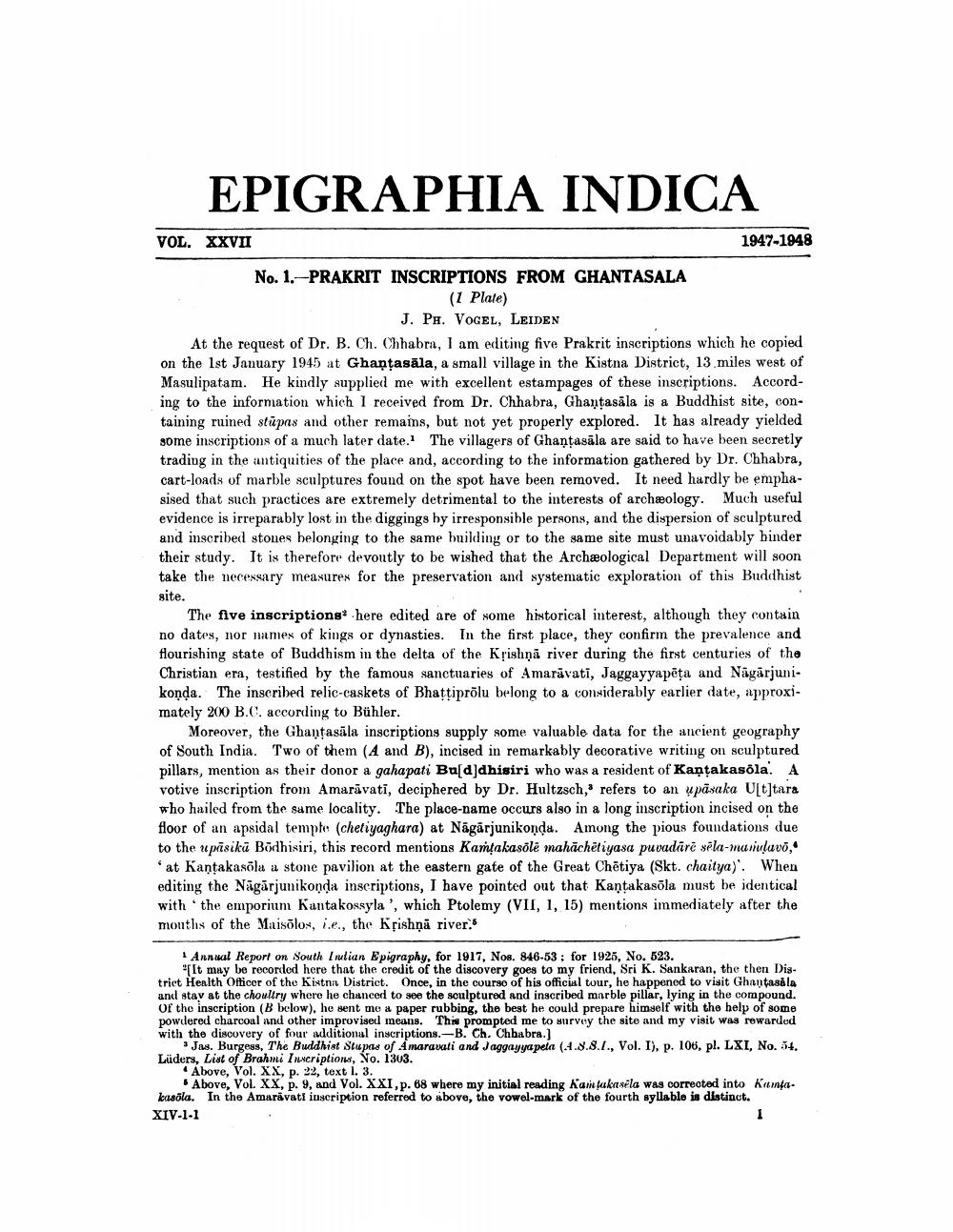________________
EPIGRAPHIA INDICA
VOL. XXVII
1947-1948
No. 1.---PRAKRIT INSCRIPTIONS FROM GHANTASALA
(1 Plate)
J. Ph. VOGEL, LEIDEN At the request of Dr. B. Ch. Chhabra, I am editing five Prakrit inscriptions which he copied on the 1st January 1945 at Ghantasala, a small village in the Kistna District, 13 miles west of Masulipatam. He kindly supplied me with excellent estampages of these inscriptions. According to the information which I received from Dr. Chhabra, Ghantasāla is a Buddhist site, containing ruined stūpas and other remains, but not yet properly explored. It has already yielded some inscriptions of a much later date. The villagers of Ghantasāla are said to have been secretly trading in the antiquities of the place and, according to the information gathered by Dr. Chhabra, cart-loads of marble sculptures found on the spot have been removed. It need hardly be emphasised that such practices are extremely detrimental to the interests of archæology. Much useful evidence is irreparably lost in the diggings by irresponsible persons, and the dispersion of sculptured and inscribed stones belonging to the same building or to the same site must unavoidably hinder their study. It is therefore devoutly to be wished that the Archæological Department will soon take the necessary measures for the preservation and systematic exploration of this Buddhist site.
The five inscriptions here edited are of some historical interest, although they contain no dates, nor names of kings or dynasties. In the first place, they confirm the prevalence and flourishing state of Buddhism in the delta of the Krishna river during the first centuries of the Christian era, testified by the famous sanctuaries of Amaravati, Jaggayyapēta and Nāgārjunikonda. The inscribed relic-caskets of Bhattiprõlu belong to a considerably earlier date, approximately 200 B.C. according to Bühler.
Moreover, the Ghantasāla inscriptions supply some valuable data for the ancient geography of South India. Two of them (A and B), incised in remarkably decorative writing on sculptured pillars, mention as their donor a gahapati Ba[d]dhisiri who was a resident of Kantakasola. A votive inscription from Amaravati, deciphered by Dr. Hultzsch,' refers to an upāsaka U[t]tara who hailed from the same locality. The place-name occurs also in a long inscription incised on the floor of an apsidal tempto (chetiyaghara) at Nāgārjunikonda. Among the pious foundations due to the upīsikū Bodhisiri, this record mentions Kamtakasõle mahāchetiyasa puvadārē sela-marulavo, 'at Kantakasõla a stone pavilion at the eastern gate of the Great Chētiya (Skt. chaitya)'When editing the Nāgārjunikonda inscriptions, I have pointed out that Kantakasõla must be identical with the emporium Kantakossyla', which Ptolemy (VII, 1, 15) mentions immediately after the mouths of the Maisõlos, ie, the Kpishņā river
1 Annual Report on South Indian Epigraphy, for 1917, Nos. 846-53 ; for 1925, No. 523.
"It may be recorded here that the credit of the discovery goes to my friend, Sri K. Sankaran, the then District Health Officer of the Kistna District. Once, in the course of his official tour, he happened to visit Ghantasala and stay at the choultry where he chanced to see the sculptured and inscribed marble pillar, lying in the compound. of the inscription (B below), he sent to a paper rubbing, the best he could prepare himself with the help of some powdered charcoal and other improvised means. This prompted me to survey the site and my visit was rewarded with the discovery of four additional inscriptions.-B. Ch. Chhabra.]
Jas. Burgess, The Buddhist Stupas of Amaravati and Jaggayyapela (4.9.8.1., Vol. I), p. 106, pl. LXI, No. 54. Lüders, List of Brahmi Inscriptions, No. 1303.
Above, Vol. XX, p. 22, text I. 3.
. Above, Vol. XX, p. 9, and Vol. XXI, p. 68 where my initial reading Kamtakasela was corrected into kantakasõla. In the Amaravati inscription referred to above, the vowel-mark of the fourth syllable is distinct. XIV-1-1




